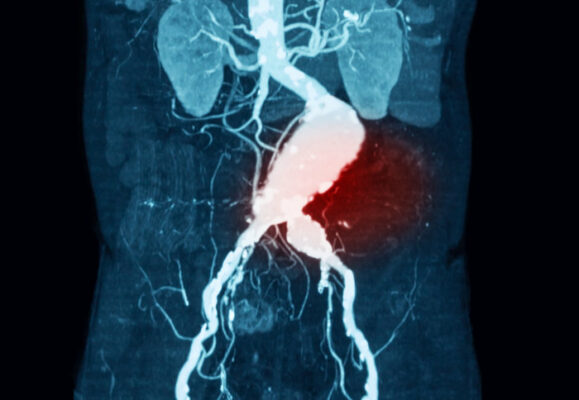Abdominal Aortic Aneurysm (AAA)
The main blood vessel in your body is the aorta. It is a long blood vessel that reaches from your chest into your abdomen. It carries blood from your heart to the rest of your body. The part of the aorta in your abdomen is called the abdominal aorta. It supplies blood to your stomach, pelvis, and legs.
Sometimes an area of a blood vessel wall will get weak. It can start to swell like a balloon and become abnormally large. This is called an aneurysm. If an aneurysm forms in your abdominal aorta and grows too large, your aorta could tear or burst.
What are the Symptoms?
As the aneurysm develops, there are usually no symptoms. This can go on slowly for years. Often, AAAs don’t cause symptoms unless they leak, tear, or rupture. If this happens, you may experience:
- sudden pain in your abdomen, groin, back, legs, or buttocks
- nausea and vomiting
- abnormal stiffness in your abdominal muscles
- problems with urination or bowel movements
- clammy, sweaty skin.
If you have these symptoms, call your doctor. immediately.Internal bleeding from a ruptured AAA can put you into shock. Shock can be fatal if not treated right away.
What are the Causes?
Doctors don’t know exactly what causes an AAA. Weaker aorta walls increase your chance of developing an aneurysm. There are many conditions that can weaken the walls of the aorta. These include aging, smoking, and high blood pressure. If any of the following factors apply to you, you are at higher risk of having an AAA.
- Being male.Men are more likely than women to develop an AAA.
- AAAs are more common in people age 65 or older.
- Personal history.If you have had aneurysms of any kind, you are at greater risk of an AAA.
- Smoking damages and weakens the aorta walls.
- High blood pressure.Having high blood pressure weakens the walls of your aorta.
- Family history.If any family members have had AAAs, you are at higher risk. You also could get an AAA before you are 65.
Talk to your doctor if you have a higher risk for an AAA, or if you have any of the symptoms.
Diagnosing AAA
Doctors commonly find AAAs by chance during a routine examination. They also find them when doing other routine tests. Doctors now recommend an AAA screening for men age 65 to 75 who smoked any time in the past.
If your doctor finds or thinks you have an AAA, he or she may order tests. Common tests include:
Ultrasound or echocardiogram – These use sound waves to create pictures of the inside of your body.
Computed tomography (CT) scan – The doctor uses X-rays to take pictures of your organs. Dye is injected into your veins so he or she can see them clearly.
Magnetic resonance imaging (MRI) – This test uses magnets and radio waves to create pictures of your organs.
Angiography – This test uses dye and X-rays to look at the inside of your arteries. This can help your doctor see how much damage or blockage there is in your blood vessels.
If your doctor finds or thinks you might have an AAA, he or she might refer to you a specialist for treatment.
Can I prevent AAA?
You can lower your risks by a healthy lifestyle including a good diet, being active and managing blood pressure.
Treatment for AAA
Treatment for an AAA depends on the size. If your aneurysm is small, it might not need treatment. They may just monitor it using routine testing. Sometimes your doctor may prescribe medicine to lower blood pressure or relax blood vessels. This can help prevent the AAA from rupturing.
If your aneurysm is large or is growing quickly, you will most likely need surgery. There are 2 main kinds of surgery to remove or repair AAAs:
Open abdominal surgery – This is the most common form of surgery for an AAA. The surgeon will remove the aneurysm via an opening in the abdomen. The removed section of the aorta is replaced with a graft made of man-made material.
Endovascular repair – In this procedure, the doctor inserts a graft into the aorta to strengthen it by inserting a catheter into your artery through your leg. The graft will be threaded through the aneurysm and then expanded. This will reinforce the weak section of the aorta and allow blood to flow normally. This helps keep the AAA from rupturing.
Living with AAA
If you have an AAA, it is important to get regular check ups. The doctor may advise you to avoid lifting heavy objects and to try to avoid highly emotional situations or crises that could raise your blood pressure.
References National Heart, Lung and Blood Institute

